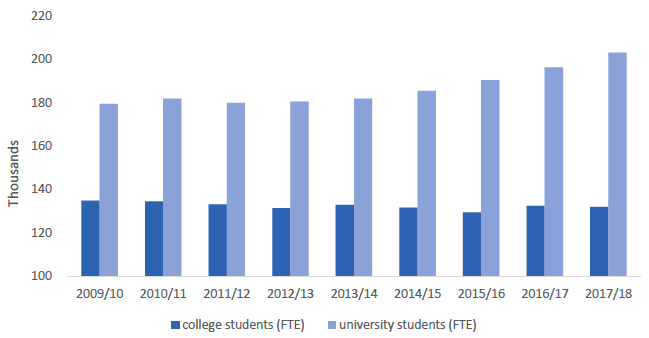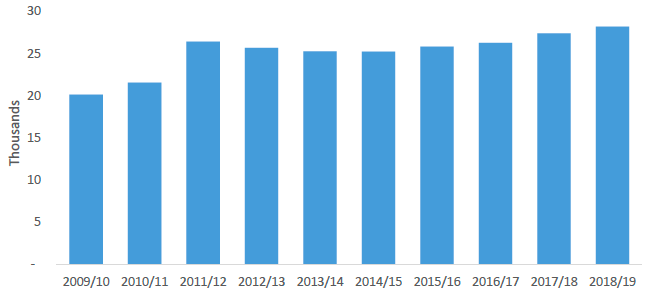Future Skills Action Plan for Scotland: evidence and analysis annex
An evidence paper to accompany Scotland’s Future Skills action plan.
Understanding Scotland’s Skills System
Why is education important?
6. Achieving economic growth that is inclusive – where prosperity is shared regardless of who you are or where you live – is at the core of the Scottish Government’s Economic and Labour Market strategies.[4] Our inclusive growth approach covers five core outcomes:
- Productivity – Businesses are competitive and economic growth is resilient and sustainable.
- Population – Scotland has a sustainable working age population.
- Participation – Inequality of opportunity to access work is addressed and jobs are fulfilling, secure and well-paid.
- People – Scotland’s population is healthy and skilled and economic benefits are spread more widely, with lower levels of inequality.
- Place – Communities across Scotland have the natural and physical resources to ensure they are strong and sustainable.
7. Skills and qualifications are a key driver of inclusive growth in that they help to drive productivity and growth, and play a key role in determining participation and inclusion. People with higher qualifications are more likely to be in employment, and developing skills can help people progress to more fulfilling, secure, well paid and fair work, which has wider social benefits.
8. Education and skills are recognised as important drivers of economic growth and productivity. Skills and qualifications can raise productivity directly by increasing an individual’s ability to do more advanced tasks that add more value to the economy. Indirect impacts include enabling the development and application of technology and innovation and can contribute to an economy’s economic growth.[5]
9. Research published by the Department for Business Innovation and Skills estimated that around one fifth of the UK’s productivity growth between 2001 and 2013 was attributed to improvements in skills levels – rising to one quarter when including workforce training. High-level skills development was also found to have been a particularly strong driver of productivity in the UK compared with other European countries.[6]
10. Empirical evidence also suggests that education is correlated with positive social and economic outcomes for individuals and the communities they live in. For example, the OECD Skills Outlook (2013) concludes that highly educated and skilled workers are more likely to be at work, they earn more on average, and are more engaged politically and socially.[7]
11. Evidence shows that a positive relationship exists between education and health levels. Across a wide-range of studies it has been proven that people with higher levels of education are more likely to live healthy lives and have better living standards.[8]
What makes a strong skills system?
12. It has been argued that a strong skills system that can contribute to economic growth, inclusion and productivity, is one where people can gain technical skills and core skills – such as interpersonal, problem-solving and team-working skills – achieved through a balance of school-based and in-work learning.[9]
13. When comparing skills systems, the evolution of a skills system within a country appears deeply linked to other factors such as a country’s institutional structures and labour market regulations (e.g. union bargaining power), suggesting that a ‘one-size-fits-all option may not exist’.[10] Nonetheless, some countries have skills systems that are considered more successful than others (e.g. Germany and the Netherlands).[11]
14. Germany’s highly regarded vocational skills system (VET), a programme combining classroom training and in-work learning, helps people develop job-related technical skills and generic skills such as interpersonal and problem-solving skills. Another strength of the German system is the alignment between workers’ skills and knowledge with the needs of manufacturing and business services sectors.[12]
15. However, even in the German system, demands for change are proposed. For example, some argue that the traditional segmentation between vocational and higher education should be reduced, or eliminated, to promote more flexible learning.[13]
16. Flexibility is something that the Scottish system is seen to do well in, with the Augar report (2019),[14] recognising that Scotland has a significantly more flexible further education system compared to England. This seems to allow colleges to respond to the demand of their local labour market.
Current participants in education
17. Participation in education has been increasing at all levels of Scotland’s education system. More young people are choosing to remain at school, with almost two thirds (62.7%) leaving in their 6th year in 2017/18, up from 55.0% in 2009/10. School leavers also have record levels of positive destinations, with 93.2% of school leavers in 2017/18 in a positive destination (39.0% in Higher Education (HE), 22.7% in Further Education (FE), 28.3% in Employment and 3.2% in other positive destination).[15]
18. Between 2009/10 and 2017/18, the proportion of school leavers going into HE and FE combined has risen from 58.5% to 61.7%. In this regard, the national qualification framework supports student progression. Specific initiatives have been launched to promote transitions, such as the regional articulation hubs which facilitate the transition from schools and colleges to university by building on local partnerships between institutions.[16]
19. University student numbers (FTE)[17] have increased from 179,350 in 2009/10 to 203,010 in 2017/18 (Figure 1). All college students (FTE) have remained relatively stable since 2009/10 at around 130,000 per year. [18] The number of apprenticeships starts have increased from 20,216 in 2009/10 to 28,191 in 2017/18 (Figure 2), this includes Graduate Apprenticeships introduced in 2016/17 but not Foundation Apprenticeships.
Figure 1: Total student numbers by type of education by academic year, 2009/10 to 2017/18

Source: Scottish Funding Council (2019), ‘Tables for HE Students and Qualifiers, 2017–18’ and SFC, ‘Infact Database’
Note: Student numbers include all domiciles.
Figure 2: Student numbers starting Modern and Graduate Apprenticeships by academic year, 2009/10 to 2018/19

Sources: SDS (2019), ‘Modern Apprenticeship Statistics - Full Year Report 2018/19’.
Note: Graduate Apprenticeships started in 2016/17. Foundation Apprenticeships (introduced in 2014/15) are not included in the above chart.
Education equalities evidence
20. Improving the diversity of participation in Scotland’s education system is a vital component of inclusive growth and can contribute to the participation and people outcomes through reducing inequality of opportunity to access education and work.
Participation Outcome
Inequality of opportunity to access work is addressed and jobs are fulfilling, secure and well-paid.
People Outcome
Scotland’s population is healthy and skilled and economic benefits are spread more widely, with lower levels of inequality.
Table 1: Males and females in MA training compared to University and College in Scotland
| Gender | MA’s in training as at 29th June 2018 | HEI students (2017/18) |
College enrolments (2017/18) |
|||
|---|---|---|---|---|---|---|
| Number | Proportion | Number | Proportion | Number | Proportion | |
| Female | 10,978 |
30% |
144,810 |
59% |
154,679 |
51% |
| Male | 26,106 |
70% |
101,940 |
41% |
147,650 |
49% |
| Total | 37,084 |
100% |
246,750 |
100% |
302,329 |
100% |
Sources: SDS (2019), ‘ Modern Apprenticeship Statistics’, Summary Information by age breakdown; SFC (2019), ‘Higher Education Students and Qualifiers at Scottish Institutions 2017/18’ – the total figure excludes 360 students whose gender is not reported or was reported as ‘Other’ and has been rounded to the nearest 5.
SFC (2019), ‘College Statistics 2017/18’ – the total figure excludes 1008 enrolments for whom the gender identity was declared as ‘other’, or was not declared at all. This includes HE and FE at college.
21. Table 1 highlights the gender split across Modern Apprenticeships (MA’s), university HEI students and college enrolments in 2017/18. This table in isolation might suggest that MAs attract more males whereas university attracts more females. However, there are significant variations in gender split when specific course enrolments are considered.
22. For example, in terms of entrants to Higher Education, in both Higher Education Institutions (HEI) and Colleges in 2017/18, 58.1% were Female and 41.7% were male.[19] Female entrants outnumbered male entrants for all subject areas except Science and Engineering where 63.2% were male and 36.6% were female.
23. A similar picture can be seen in MA starts where 62% were male in 2018/19 and 38% female.[20] There is a high level of gender segregation in some frameworks. For instance the largest occupational grouping, Construction & Related, 2% of starts were female compared to 98% male in 2018/19. While the second largest Occupational Grouping, Sport Health & Social Care is primarily dominated by Females (84% to 16%).
24. While it varies across courses, in general, females achieve better education outcomes than males. For instance, females had higher pass rates than males for both Highers (80% vs 74%) and Advanced Highers (84% vs 77%) in 2018.[21] At university, for first degree qualifiers, females were more likely to graduate with a first or upper second compared to males (82% vs 77%) in 2017/18.[22]
25. In terms of further study, females attending college were more likely to progress to further study than their male counterparts, with 76.5% progressing to further study compared to 73.1% of males in 2016/17. However the opposite is true when considering the progressing to ‘work’, with males (22.0%) more likely to take this route than females (18.5%).[23] In Modern Apprenticeships, with 94% of females in work or further study six months after completion of their MA, compared to 92% of males.[24]
26. In terms of equality of access across socio-economic groups, HEIs and colleges in Scotland have improved their performance. In 2017/18, 18.9% of Scottish domiciled undergraduate HE entrants came from Scotland's 20% most deprived areas. This represents an increase of 1.9 percentage points from the 2013/14 .[25] Also, in 2017/18, 34.1% of full-time Scottish domiciled FE college entrants came from Scotland's 20% most deprived areas. This represents an increase of 3.3 percentage points from 2006/07 and is the highest figure on record.
27. The proportion of minority ethnic students in university and college in Scotland has generally been increasing over the time period since 2003/04. Figures from the Scottish Funding Council (SFC) show that the highest proportion of minority ethnic students (11.7%), are in part-time FE study at college, followed by full-time first degree level – where 8.7% of entrants in 2017/18 were from a Black and Minority Ethnic (BME) background.[26]
28. From 2013/14 to 2017/18 the proportion of entrants with a declared disability has increased across all full-time modes of study.[27] According to figures from the SFC, in 2017/18, the highest proportion of students with a declared disability in Scotland was at full-time FE level in colleges, where 22.5% of entrants had a declared disability.
Contact
Email: Dominic.Mellan@gov.scot
There is a problem
Thanks for your feedback